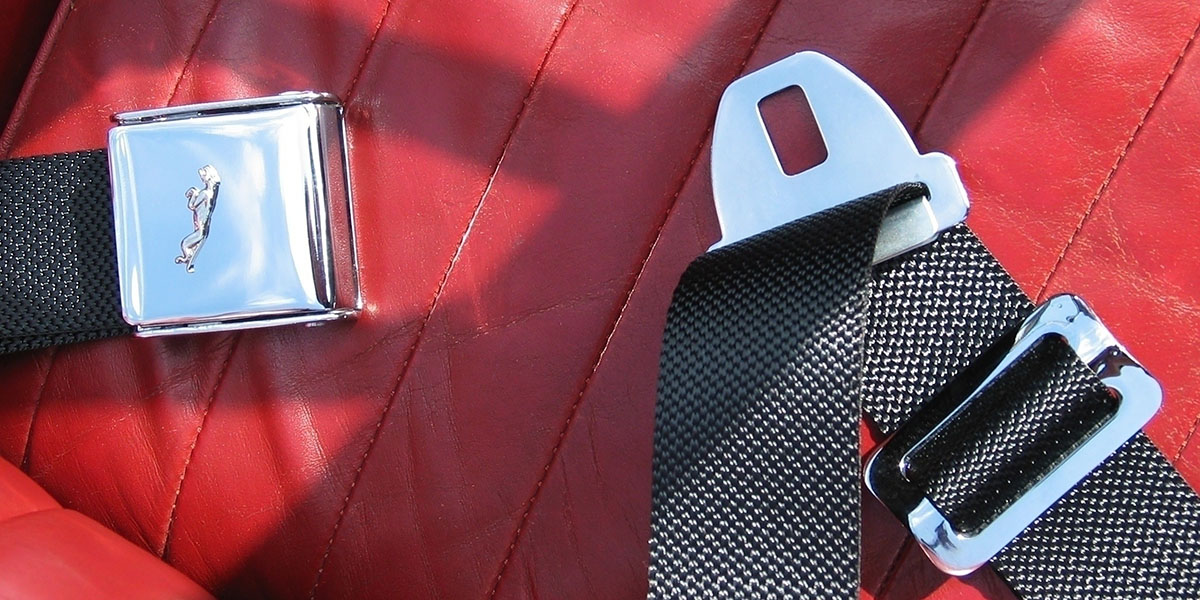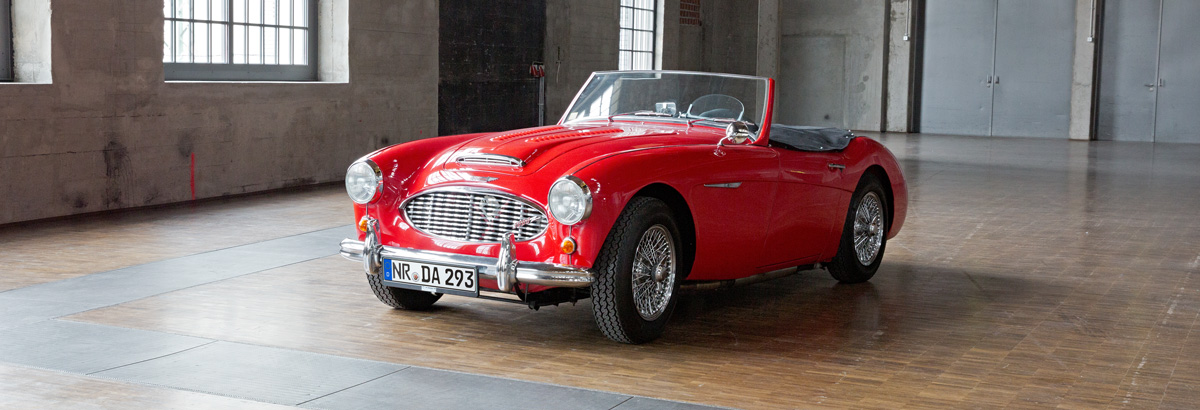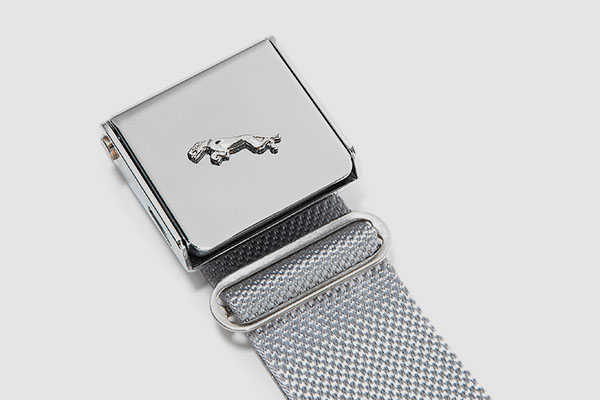Is there a retrofitting obligation for vintage car
seat belts?
Have you already asked yourself whether you want to equip your favourite classic with belts or replace existing belts? Safety reasons play a major role in this decision. Sometimes also the question of compulsory seat belts. Find out here what the situation is in this respect and what you need to bear in mind if you want to - or even have to - retrofit your classic car with seat belts.

Position: Sales
Updated on: 21.11.2023

Seat belts in classic cars: legal regulations from 1970 onwards
Today, many classic cars are either not equipped with seat belts at all or (at least for some drivers' sense of safety) not sufficiently equipped with seat belts. This is because they only became compulsory - with existing attachment points - in 1970.
In 1974, there was a transitional regulation stating that seat belts should be retrofitted in all vehicles built after that date if the manufacturer had not already done so. These belts, however, are lap belts rather than the safer three-point belts that the safety pioneer Volvo had already been installing since 1959.
In addition, until 1979 the regulations only took into account driver and passenger seats, so the rear seats look rather poor in this respect.
Attention: Since 2006, a vintage car carrying children under 3 years of age must be equipped with seat belts. If children under 1.50m tall or under 12 years of age are on board, they must sit in the rear. If the vehicle is only equipped with seat belts in the front, they must ride in the passenger seat with a secured child seat.
Vintage car seat belts: compulsory retrofitting yes or no?
For some vehicles, retrofitting is mandatory for classic car seat belts. However, this does not mean that you have to retrofit your own jewel: According to § 2 No. 22 of the German Vehicle Registration Ordinance (FZV), classic cars that are at least 30 years old or were registered before 1 April 1976 and are largely in good original condition are exempt from the current seat belt obligation and may be driven without seat belts.
Exceptions and special cases when retrofitting belts
In general, this means that it is sufficient for a vehicle to comply with the safety regulations that were valid when it was first registered. Nevertheless, as always, there are exceptions to consider, where various retrofits might be pending. These mainly concern classic cars that have been imported from abroad or those in which new and used parts have been installed. This includes, for example:
- Vehicles where damaged parts have been replaced with new parts, but which are still clearly identifiable.
- Vehicles produced for other national markets without compulsory seat belts.
- Replicas and kit cars, for which different rules apply in Germany than in England, for example.
Here again the following question arises:
When does a retrofitting obligation apply to my vehicle?
Quite simple: If the assignment of the vehicle documents with the identification number (VIN) is still possible, then it is considered to be the original vehicle and therefore the registration regulations at the time of the initial registration also apply.
The date of the first registration noted in the registration documents defines that all regulations existing at that time also become valid for the vehicle. In this case, there is not only a safety belt retrofitting obligation for your classic car, but also one for hazard warning lights, reversing lights, steering wheel lock, etc., if applicable.
What you need to bear in mind when retrofitting your classic car with seat belts
If you are a fan of good safety equipment
or have children who like to accompany you on outings, then the
decision to upgrade will already have been made. In this case, there are
a few things to consider to ensure that everything is done correctly
and that your classic car also retains its status as a historic vehicle.
Retrofitting seat belts in a classic car yourself
In principle, it does not matter whether you retrofit modern 3-point automatic belts or contemporary static belts. The important thing is to install them properly.
In principle, there is always a certain risk when retrofitting seat belts for classic cars, because everything must be mounted safely according to the rules of the StVZO (Road Traffic Licensing Regulations). The original condition should be preserved as much as possible. Beginners are therefore not advised to do this.
If you still want to install the classic car safety belts yourself, you should first check whether there are already retaining points. If retaining points are present, the installation of vintage car belts is quite easy, especially on models from the 50s and 60s.
If the anchorage points are not available, the recommendation is to rather contact a specialist workshop for the installation of the classic car seat belts. Because if holes have to be drilled because there are no anchorage points yet, reinforcement plates must also be welded in. After all, in the event of a collision, the belt is supposed to provide a certain amount of protection. And this is only guaranteed if the attachment point does not tear out of the unreinforced sheet metal.
Tip: Vehicles without a B-pillar offer few options for attaching the upper deflector. You can either mount the deflection or the reel itself to the nearest fixed sheet metal part. Your SC Parts sales representative will be happy to explain specially adapted belt systems with freely movable pulley mechanisms to you on +49 2683-9799-0.
Have classic car seat belts fitted by a professional
There are plenty of providers who specialise in retrofitting. Body shops professionally install seat belts for classic cars and take care to preserve the originality of the gem.
At SC Parts, we offer these special solutions for the installation of seat belts and have various colours and excess lengths to choose from. So you will definitely find the optimum belt for your classic car. Ask your SC Parts consultant on +49 2683-9799-0.
However, there may be complications even for the professional: bodies with wooden frame, generally insecurely built cars or small vehicles make installation more difficult. In such cases, retrofitting seat belts does not always make sense. Seek advice before buying whether installation is possible.
Retrofitting classic car seat belts for the child seat
Child seats must comply with ECE standard R44 or 04. These can be fastened with a three-point belt just like in newer vehicles. An alternative option is the Isofix system, which is screwed to the body of the vehicle via two additional eyelets. There are no certified Isofix mountings in classic vehicles.
In any case, first make sure that the child seat fits in your classic car before you carry out an installation.
Important: All new installations must comply with StVZO. All standard belts have an E-approval mark, so they do not have to be registered separately. Incidentally, from the point of installation, seat belts are also compulsory, because if seat belts are present, they must be used.

Does the retrofitting of classic car seat belts endanger my H-licence plate?
The H registration plate is a clear advantage for many classic car drivers: it means lower taxes and often lower insurance premiums for larger vehicles, and the vehicles can also be driven in environmental zones without a catalytic converter or sticker.
However, this also means that the question always arises as to whether the H registration plate is jeopardised by the modification, because not all conversions, additions or repairs are compatible with the requirements for the registration plate.
For the H licence plate, the main focus is on preserving the original condition, because after all, it is a historical cultural asset that should be treated with care and be authentic.
According to Markus Tappert (TÜV Süd Serviceline Classic), if the conversions are carried out correctly, taking into account the original condition, the H registration plate is not jeopardised by the retrofitting. Retrofitted headrests are also accepted.
When is it necessary to replace classic car seat belts, airbags and the like?
Even seat belts cannot always be maintained for decades, even with the best classic car care . In addition, another problem is that the belt mechanism can wear out over the years or - for example after an accident - is no longer 100% functional. The same applies to other parts, such as the airbag, which should be replaced after 10-14 years with some manufacturers.
Check seat belts
Normally, it is assumed that seat belts last for the life of the car. However, you should not necessarily rely on this. A closer look at a used car, for example, can show whether the belts have already been strained in an accident and need to be replaced:
Each belt has seams at the lower end in the sill area, approximately at the level of the coloured patch with the approval information. These seams must not be damaged under any circumstances.
Also urgently need to be replaced:
- faded belts
- Belts with worn edges
- Belts with punctures or kinks
- Belts with traces of melting or rubbing.
Also check that the return spring is working properly: If the retractor
jams, even if you pull it out carefully, the belt is no longer usable.
Check airbag
With an airbag, it is a little more difficult to check that it is working properly. In Europe, some classic cars have been equipped with airbags since 1981. At first only in the steering wheel, later airbags were also installed in other places in the passenger compartment or even in the seat. However, the first vehicles with airbags were top-of-the-range cars from premium manufacturers. Their service centres are easily able to electronically inspect an airbag.
If airbags are installed in the vehicle, they must also function. Electronic faults are indicated by an airbag indicator light and stored in the vehicle's fault memory. A service company with a brand-specific test device can also help here.
The actual pyrotechnic propellants that provide for the inflation of the airbag are usually unproblematic. The places you should check yourself are:
- Plastic parts: These can become brittle over decades and it is therefore important to take a close look at the covers of the steering wheel or the airbags. If the folded airbag is visible, it has already been damaged by UV radiation.
- Indicator light: The indicator light for the ignition lead shows whether the airbag function is actually impaired.
- Cables: The sheaths of the cables can harden over time, because brittle insulation can cause short circuits.
In fact, however, there is no regular obligation to replace airbags.
Incidentally, the same applies to the seat belt pre-tensioners introduced in the 1980s, which use a pyrotechnically powered unit to tighten the belt around the body in the event of an accident: The belt itself or the reel can wear out, the belt tensioner itself is inconspicuous and maintenance-free.
Retrofitting seat belts - What models are available?

Vintage car seat belts and airbag: costs
In principle, belts are available in all colours and with many different weave patterns for all classic vehicles of different eras. Retrofitting classic car seat belts does not usually cost a fortune - even for professionals and special models. However, it is not cheap:
Costs: Starting at about 50€ for the simple black three-point belt, you have to reckon with 200 euros upwards for special requirements per belt. On top of this, there is the installation.
Important:
Do not store removed airbags or seat belt pre-tensioners in the garage.
Hand in the undeployed airbag to the specialist dealer or a service company for disposal.
The gas generators installed in the airbag must be professionally deactivated.
Deployed airbags are disposed of with the metal scrap.